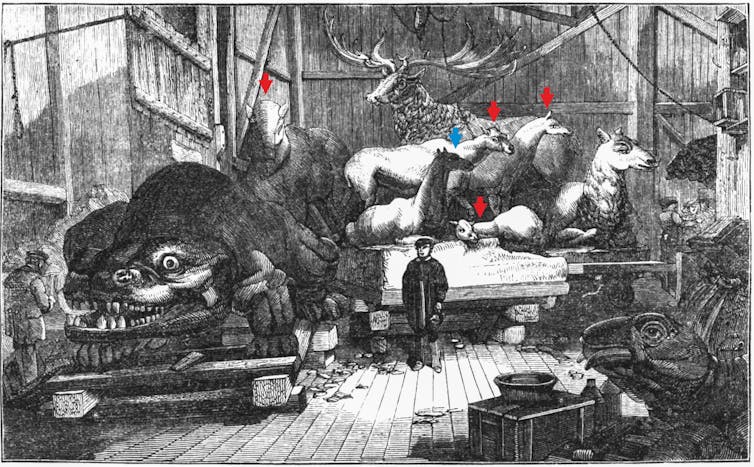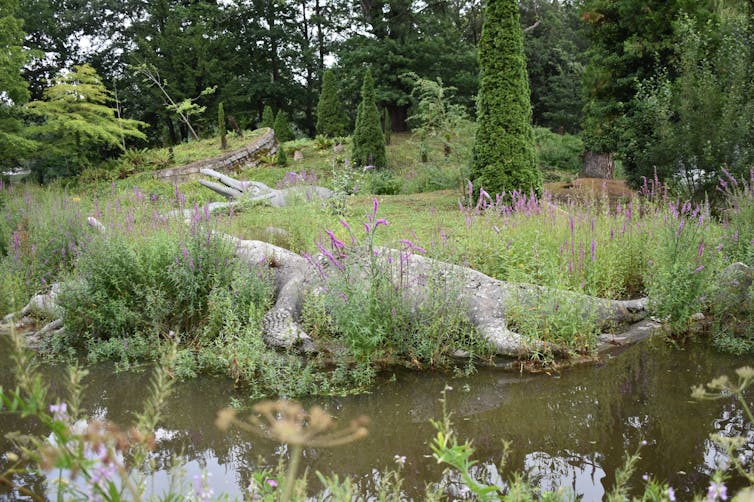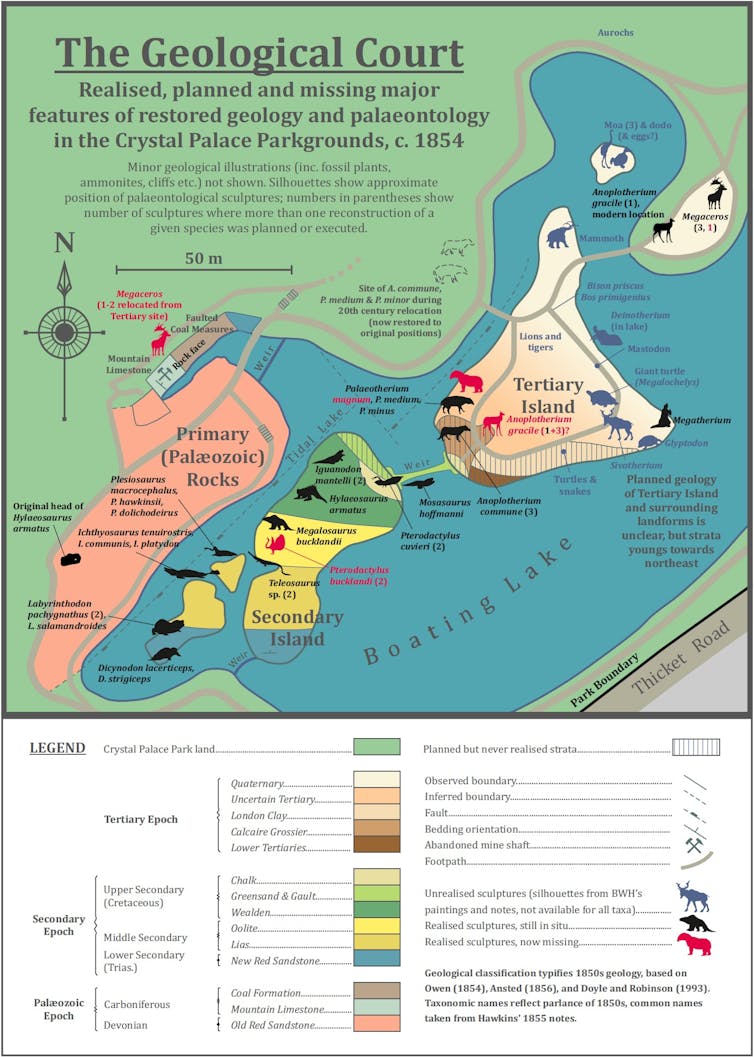Published: May 20, 2022
This summer sees our love for dinosaurs manifest in two major releases: the David Attenborough documentary Prehistoric Planet, and Jurassic World: Dominion. Such multi-million dollar projects are a far cry from the first attempts to bring dinosaurs to life in people’s imagination.
Perhaps the most famous of these took place almost 170 years ago at Crystal Palace Park, in south-east London, where over 30 life-sized sculptures of prehistoric animals, including dinosaurs, revealed extinct life to the public for the first time.
Much like the unveiling of Jurassic Park’s computer generated dinosaurs in 1993, the Crystal Palace dinosaurs stunned visitors. This historic site still enjoys hundreds of thousands of visitors each year.
Our new book, The Art and Science of the Crystal Palace Dinosaurs, reveals that neglect of the site allowed seven – almost a fifth – of the original sculptures to disappear. It was thought the original park had 32 sculptures, of which only 29 originals (with one replica, making 30) stand today. We showed 37 once existed.
Get your news from people who know what they’re talking about.Sign up for newsletter
The lost statues include the tapir-like Palaeotherium magnum, three delicate llama-like Anoplotherium gracile, two Jurassic pterodactyls, and a female giant deer. It’s unknown when and how each vanished, but dereliction, site redevelopment and perhaps vandalism may be responsible.
Built as part of the Crystal Palace Park project, the dinosaurs were unveiled in 1854 and completed in 1855. Although books and magazines brought dinosaurs to the attention of the rich and educated in the early 1800s, fossils were an interest reserved for the upper tiers of society. The sculptures, crafted by a team led by Benjamin Waterhouse Hawkins, aimed to introduce prehistoric life to the wider public.
Working with geologists David Thomas Ansted and Joseph Campbell, Hawkins created a learning experience one part spectacle and one part enlightenment: the “Geological Court”. This showcase of geological and palaeontological science allowed visitors to walk through geological time.
The largest of Hawkins’ sculptures were the dinosaurs, reaching over 10m long. Mock geological features contained hundreds of tonnes of rocks sourced from all over the UK. This was expensive blockbuster edutainment.
For all the mockery cast on the sculptures for their scientific inaccuracy today, at the time they were cutting edge representations of extinct species – and a major hit with the public. But budget issues saw the site fall into disrepair from 1870 onward. Degraded and patchy records mean the full extent of the original display is uncertain.

An 1853 image of the Crystal Palace palaeontological sculpture workshed. Several now missing models are indicated by red arrows: the Palaeotherium magnum (left) and three Anoplotherium gracile (right). The surviving A. gracile is marked with a blue arrow. Image in public domain, modified by Mark P. Witton and Ellinor Michel.
Virtually no physical remains of the missing sculptures exist. Only archive photographs, illustrations and texts prove their existence. For example, the image above shows several models that no longer exist.
From these sources, we also re-identified one sculpture at the park – an alleged giant deer fawn – as Anoplotherium gracile, which resembles a gazelle and is the sole surviving representative of what was once a group of four statues.
If we know almost 20% of this unique Victorian site was allowed to vanish so quietly, what else might be missing?
A history at risk of extinction
While the Victorian artistry and creative engineering that went into creating the Geological Court is celebrated today, the site has long suffered from a lack of conservation.
The unchanging nature of the concrete displays, now numerous generations behind the latest palaeontological findings, gives a sense the they will always be here. But visit the site today and it’s obvious many of the displays are still crumbling.
Weathering, vandalism and redevelopment mean the Geological Court is a blend of originals and replicas of structures destroyed in the mid-20th century.

The state of the southern corner of the Geological Court as of 2021. This portion of the site has received some minor maintenance since this photo was taken.
There is hope. The Friends of Crystal Palace Dinosaurs charity was established in 2013, and the entire site is now Grade 1 listed and on the official Heritage At Risk Register by Historic England.
But the Geological Court’s status is a precarious one. Without urgent conservation the sculptures face major deterioration.
As you enjoy the digital descendants of Hawkins’ dinosaurs when they hit our screens this summer, spare a thought for their Victorian ancestors. To lose what remains of these displays, that changed the way many people thought about life on Earth, would be tragic.
Research Fellow in Palaeontology, University of Portsmouth
Scientific Associate, Natural History Museum
Disclosure statement
Mark P. Witton is the co-author of The Art and Science of the Crystal Palace Dinosaurs, out now on Crowood Press.
Ellinor Michel is the co-author of The Art and Science of the Crystal Palace Dinosaurs, out now on Crowood Press.
New discovery of missing Victorian
dinosaurs at world’s first Jurassic Park
IMAGE: THE LONGEST SCULPTURE IN THE PARK IS MEGALOSAURUS, THE ORIGINAL CARNIVOROUS DINOSAUR. THIS RESTORATION SHOWS THE ARTISTIC SKILL AND SCIENTIFIC CONSIDERATION THAT WENT INTO EACH MODEL THROUGH ITS MUSCULAR, POWERFUL LIMBS, ENLARGED, HEAD-SUPPORTING SHOULDERS AND FINELY DETAILED JAWS. view more
CREDIT: MARK P. WITTON
- New insights about the world’s first life-sized models of dinosaurs have been revealed.
- A new book provides missing evidence that seven - almost a fifth - of the world-famous Crystal Palace Dinosaurs have disappeared.
- The lost sculptures include the tapir-like Palaeotherium magnum, three delicate llama-like Anoplotherium gracile, two Jurassic pterodactyls, and a female giant deer.
Evidence for numerous missing models at the world-famous Crystal Palace Dinosaurs and re-identification of a sculpture as one of the park’s “lost species” are revealed in a new book, The Art and Science of the Crystal Palace Dinosaurs (The Crowood Press).
The Crystal Palace Dinosaurs were a series of over 37 Grade 1 listed sculptures of prehistoric animals and geological displays arranged in a simulated “walk through time”, which were unveiled to the public as part of the famous Crystal Palace Park in 1854.
It was thought the original park had 32 life-sized sculptures, of which 30 (29 originals and one replica) and a handful of geological displays survive today. The new research adds five lost mammal sculptures to that list, showing that 37 sculptures once existed.
This globally significant historic site, which includes iconic depictions of monumental dinosaurs, regal extinct mammals, serpentine marine reptiles and giant amphibians, captured a snapshot of palaeontology from a golden era of scientific discovery in the mid-19th century. Today, they are internationally recognised as a milestone in the portrayal of extinct life and the history of science.
The book’s co-author, Dr Mark Witton, a leading palaeontological artist and researcher at the University of Portsmouth, said: “We’ve uncovered a lot of new insights into the Dinosaurs and their park home in this project, but the evidence for so many lost models blew us away. They weren’t small, obscure sculptures either, but included pony-sized, tapir-like Palaeotherium magnum and a horse-sized female Megaloceros. More amazingly, we found lots of evidence for a hitherto overlooked species, ”Anoplotherium gracile”, which we call Xiphodon gracilis today.
“There were originally four Xiphodon but only one model survives, mislabeled as a Megaloceros fawn. Happily, we have photos and illustrations of these lost models that show us what they looked like, but their existence also exposes large gaps in the documented history of the site. It means that, in total, eight original models have been lost, with only one successfully replaced - a standing Anoplotherium commune.”
Using new archive sources, the authors have revealed how grand the site was in its heyday before almost 20 per cent of the original constructed animal sculptures went missing in following decades, mostly under unknown circumstances. In addition, 14 planned extinct animal sculptures were never made due to funding restrictions.
Several mysteries about how the non-dinosaur animal models were manufactured have also been answered. Using new analysis of historic images, the authors discovered that the smaller sculptures were probably built indoors and moved around with carts, sometimes in pieces, to be assembled on site. The largest models, including the dinosaurs, were assembled in place, under tents to protect them from poor weather.
Co-author Dr Ellinor Michel, an evolutionary biologist at the Natural History Museum London, said: “This book celebrates these classic scientific artworks and explores their history, their conception as a wider part of the Crystal Palace project, their execution using unorthodox building materials, their reception by 19th century and modern critics, and their enduring mysteries.
“These sculptures and landscapes have been a gateway to the wondrous ideas of Deep Time and to teaching us how scientific ideas come to life since 1854. These Victorian creations can still teach us a lot today about science, art and history. I hope this book will continue to bring those important messages to many generations of curious minds.”
The book, which is published by The Crowood Press, includes hundreds of historic and modern photos and original paintings that offer a detailed study of the art and science behind each sculpture, and covers:
- How prehistoric life and the geological record was reconstructed at life-size for the first time in the 1850s, detailing how the models and their associated geological landscape were rationalised from scientific data before being rendered in iron and concrete.
- How palaeoartists and palaeontologists view them today, with a discussion of their historical reconstructions and the debates about the animals over time.
- An evaluation of the roles performed by the site’s consultant, the historically controversial scientist Richard Owen, and its visionary artist, Benjamin Waterhouse Hawkins.
Dr Witton said: “The Crystal Palace Dinosaurs are the world’s first major palaeoart project and they played a significant role in making geological sciences accessible to the public. This is the most detailed and complete history of these world-famous sculptures yet, reinforcing their status as masterworks of education and palaeoartistry.”
Unfortunately, conservation risks have faced generations of custodians keeping the display intact, and the challenges still face the site today.
Dr Michel, who is co-founder and chair of the Friends of Crystal Palace Dinosaurs, said: “The need for greater care, maintenance and research in the Geological Court is even more urgent than anyone knew as the site has suffered more damage than we thought. Through this book, we want to show the importance of conserving these endangered sculptures for the next generation.”
All authors’ royalties from the book will support the charity Friends of Crystal Palace Dinosaurs to help in the conservation and interpretation of the models.
ART AND SCIENCE OF THE CRYSTAL PALACE DINOSAURS
£30.00
CAPTION
Cover of The Art and Science of the Crystal Palace Dinosaurs.
CREDIT
The Crowood Press
ABOUT THE AUTHORS
Mark P Witton is a leading palaeontological artist, author and researcher at the University of Portsmouth, UK. He has produced artwork for museums and universities worldwide, including Natural History Museum, London, and American Museum of Natural History, and acted as a consultant for documentaries and films, including the Walking with Dinosaurs franchise. He has written numerous books on palaeontology and palaeoart, including The Palaeoartist’s Handbook and Recreating an Age of Reptiles for Crowood. After learning about Crystal Palace Dinosaurs as a child, he is thrilled to have made this contribution to the scholarship of this important, unique site.
Ellinor Michel is an evolutionary biologist, ecologist and taxonomist at the Natural History Museum, London. Her work extends to palaeoclimates and scientific nomenclature. It was her interest in the history and philosophy of science that led her to co-found and chair the Friends of Crystal Palace Dinosaurs. The Dinosaurs have been a gateway to the wondrous ideas of Deep Time and to teaching us how scientific ideas come to life since 1854, she hopes this book will continue to bring those important messages to many generations of curious minds.
Art and Science of the Crystal Palace Dinosaurs - The Crowood Press


No comments:
Post a Comment